 |
||||
Second Language Learning
|
||||
| Learner: My father
says me to be on time.
Mentor: "tells me to." L: "tells me." M: "Give me the whole sentence: 'My father tells me to be on time.'" L: "My father tells me to be on time." M: "My brother." L: "My brother tells me to be on time." M: "Boyfriend." L: "My boyfriend tells me to be on time." M: "father . . . friend Juan . . . grandpa . . . teacher . . ." etc. |
Practice the 3-minute drill as many times as necessary until the learner can easily and fluently express the sentence. Note: to help drive home the correct pattern, the mentor should then change another part of the sentence My teacher tells me to . . . speak louder . . . study hard . . .arrive early etc. Then, follow with changes in different combinations the goal is not only to learn it intellectually, but to be able to say it quickly, fluently, and without thinking about it. Second language learning practice means that your words roll smoothly off your tongue.
And here's a quick variation for the him/her problem:
| Mentor:
My father told me to bring him a newspaper.
L: "My father told me to bring him a newspaper." M: "Mother." L: "My mother told me to bring her a newspaper." M: "Brother." L: "My brother told me to bring him a newspaper." M: "Boyfriend . . . sister . . . cousin Amanda . . . etc." followed by "Loaf of bread . . . a Coke . . a liter of bottled water . . . his/her slippers . . . etc." |
Read real second language learning examples,
Click here for Spanish tutorial: Meet my Tandem, Mariarosa Holdado Vargas
Click here for Contaminated Bottle Water = Urgent Errand!
Click here for Little Known Facts about Peru History: Choqeuqirau: What's That?
Master the art of asking short questions
Even with a limited vocabulary, mastering the art of asking snappy questions is a great way to keep the conversation flowing and shade in your grasp of the topic at hand, bit-by-bit. Add this technique to your second language learning strategies; it is particularly helpful if you can start with questions requiring short, factual answers that can lead to other questions.
Enhance your intercultural communication by starting with the journalis's tried and true questions: who, what, where, and when. Shade in meanings with more specific questions, like how much, how long, what kind. As you expand your skill, go on to why and how, and eventually ask about preferences, opinions, and feelings.
- Master the art of asking short questions: they keep a conversation flowing . . . but be sure to temper your initial enthusiasm with a bit of practicality.
Read a real language immersion example,
Click here for Little Known Facts about Peru History: Choqeuqirau: What's That?
Capture your weekend experiences on paper
Whether your primary objective is to learn to speak, read, write, or listen with understanding another language or some combination your vocabulary will benefit from writing about your experiences. Keep in mind, however, your ability to articulate an "authentic" accent is best incubated in an oral approach at first, to avoid the "eyeball bias" of pronouncing the sounds of your new language the way they look as you would your native tongue, that is. Let your ears do the initial work during your second language learning practice! Its harder, but the payoff is worth it.
With that said, there are two ways to write about your weekend excursions you can write them directly in your new language, or you can write them first in your native language. The benefit of writing them in your new language is it removes the liability that comes from writing in a style that may be suited more to your native language. The drawback is you will find yourself limited by your command of vocabulary and grammar.
The benefit of writing your stories in your native language, then translating them is that it will stretch your command you will learn new vocabulary and new forms. And, of course, you will need help from a good dictionary, grammar book, or native speaker or all three. The downside is you likely will create awkward constructions that sound fine in your native language, but may not make sense in your new language. And it's harder.
To get maximum benefit, try both second language learning strategies.
- Embrace the unexpected; allow it to introduce you to new experiences.
- Write your experiences in your native tongue, then translate them to your target language.
Read real language immersion examples that Ann first wrote in English, then translated to Spanish (with help from her teacher, Jacky),
Click here for New Seven Wonders of the World, Machu Picchu and Mystical Moments
Click here for Siete Maravillas del Mundo: Mistico Machu Picchu
Practice the art of story-telling
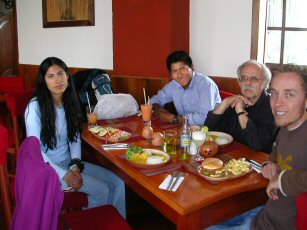 Another second language learning strategy is to tell oral stories also an excellent source of practice for your
growing language ability. Telling stories is a great way to enhance your intercultural communication.
Working with your mentor, your tandem, or your host family, youll get a good workout for
both your pronunciation and your command of past tense verb forms. To expand your abilities with other verb forms,
talk about your plans, as well this weekend, Ill go to
, I would like to see
, I hope the weather is good
etc.
Another second language learning strategy is to tell oral stories also an excellent source of practice for your
growing language ability. Telling stories is a great way to enhance your intercultural communication.
Working with your mentor, your tandem, or your host family, youll get a good workout for
both your pronunciation and your command of past tense verb forms. To expand your abilities with other verb forms,
talk about your plans, as well this weekend, Ill go to
, I would like to see
, I hope the weather is good
etc.
- Tell weekend stories they're a natural way to learn the past tense.
- Write your stories down writing builds naturally on your oral stories.
- Write more complex stories in your mother tongue, then translate them to your target language you'll expand your vocabulary and command of grammar naturally.
- Use your stories to practice your language in different settings.
Read real language immersion examples,
Click on The Road to Moray: Our Peru Adventure Vacation
Click on Mario Vargas Llosa Teaches (Practical) Spanish
Click on Contaminated Bottle Water = Urgent Errand!
Attune yourself to the living classroom of the world around you to
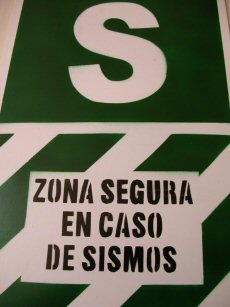 If your second language learning involves cultural and language immersion, youre probably surrounded by free lessons micro-lessons,
that is coming at you from all sides. From the (sometimes bilingual) signs at the airport and elsewhere, to the ubiquitous
loud cell phone conversations, to rapid-fire television and radio commentators, you have numerous options for
exhange language. Mine them for all you can! Any time is a great time for second language learning practice.
If your second language learning involves cultural and language immersion, youre probably surrounded by free lessons micro-lessons,
that is coming at you from all sides. From the (sometimes bilingual) signs at the airport and elsewhere, to the ubiquitous
loud cell phone conversations, to rapid-fire television and radio commentators, you have numerous options for
exhange language. Mine them for all you can! Any time is a great time for second language learning practice.
- Build new vocabulary.
- Ferret out meaning in existing vocabulary.
- Intuit new ways to put words together.
- Build listening skills.
Read real language immersion examples,
Click here to read Free Spanish Lessons
Click here for Tandem Learning: Real Life Practice in Basic Spanish Grammar
Go beyond "Student language:" get a local to take you off the beaten path

Your formal language teachers and your homestay family offer the easiest access to using the language in natural settings. But heres a caveat: skilled teachers and family members quickly develop the art of using "student language" they understand what you mean, despite the heavy accents, the wrong words, and faulty intonation. And they learn to limit their vocabulary and sentence structures so you can understand. Enhance your intercultural communication by including these antidotes among your second language learning strategies:
Learn from your teachers and family members, but get them to introduce you to friends and to take you into the community where you'll meet people unaccustomed to hearing foreign speakers. Then,
- Go on your own: seek out natural settings where you're the only foreigner, where people speak naturally rather than tailor their language to newcomers.
Click here for The Road to Moray: Our Peru Adventure Vacation
Click here for Ecotourism Travel in Lake Titicaca: Amantani Overnight
Click here for Contaminated Bottle Water = Urgent Errand!
Keep a diary or journal
For the inveterate journal-keepers, make the most of it take advantage of your discipline to record at least some of your thoughts in your target language. Capture language exhanges that you have with others. Do it even if you don't regularly keep a journal. Think of it as exercise for your brain to keep you focused on your second language learning. If you get stuck in trying to express something, use it as fodder for discussion with your language teacher.
- Use it to spice up your language sessions.
Read real language immersion examples,
Click here for Spanish tutorial: Meet my Tandem, Mariarosa Holdado Vargas
Click here for Write a Personal Journal
Hold class in a taxi
A taxi is a good example of a second language-learning opportunity because the driver is, for a few minutes, a captive audience. It's your job to strike up a conversation because he will no doubt assume you don't speak the language. Why waste precious hours driving to destinations in silence, when a taxi ride with a real live native speaker can be among your most delightful intercultural communication opportunities?
- Take advantage of captive audiences: strike up a conversation.
- Ask questions: it's amazing what you'll learn (and what people will tell you). Even if you know the answer, ask about:
- Street activities, events you pass: "What's the parade for?"
- Road or construction projects: "Gee, what are they building there?"
- The weather: "Sure has been raining, hasn't it?" "Is it always like this?"
- Current events (listen to the radio for national or local stories): "How did the soccer team do against Bolivia last night?" "Whew, tough game last night, no?"
- The driver's job: "Been driving a cab long?" "You guys must work long hours, no?" "Price of gas sure has been high, hasn't it?"
Read real language immersion examples,
Click here for Learn Spanish in Peru: Taxi-ing our way
Send a thank you note
Send thank you notes for the myriad acts of kindness you encounter. You will do more than exercise your language abilities. This second language learning strategy will build you a gold mine of good will and enhance your intercultural communications.
- Look for opportunities to hone your skills.
- Try new things: look at the world from a different perspective.
Read real language immersion examples,
Click here for Waiting for a Jewelry Buyer: Chela's Story
Click here for Spanish tutorial: Meet my Tandem, Mariarosa Holdado Vargas
Engage with that gang of kids
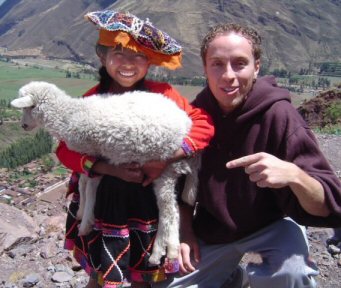 Almost anywhere you go as a foreigner, you will encounter young kids who are willing, and yes, eager to talk to you.
Engage with them in their language and you will find yourself enriched. Younger kids tend to use more limited
vocabulary and grammatical forms, so you are less likely to get lost. Further, if you are open to new experiences
as well as new second language learning strategies, they will give you a perspective on your host country that you
won't find elsewhere.
Almost anywhere you go as a foreigner, you will encounter young kids who are willing, and yes, eager to talk to you.
Engage with them in their language and you will find yourself enriched. Younger kids tend to use more limited
vocabulary and grammatical forms, so you are less likely to get lost. Further, if you are open to new experiences
as well as new second language learning strategies, they will give you a perspective on your host country that you
won't find elsewhere.
- Things aren't always what they seem at first glance, are they?
- Language and culture teachers come in all sizes, even pint-sized ones.
Click here for Peru Shopping: High Finance in Changing Money.
Take a bilingual tour
Look for bilingual tours in your locale, the kind that use both the local language as well as your native language. Listen to both, and you'll reap several benefits. You'll get immediate translation between the two to help you with new vocabulary. You'll get more out of the tour because guides rarely repeat the entire spiel twice; they'll forget something, but if you're paying attention, you'll get the full story. And, because guides often switch which language they lead with, you'll get two second language learning strategies for the price of one: exercises in going from your native language to the target language, and vice-versa, which turn out to be very different activities.
- A bilingual English-Spanish tour can stretch your Spanish skills: listen closely to both versions; as much as possible ask questions in your target language; encourage the tour guide to offer translations.
- Write down those local names your guide gives you: towns, buildings, peaks, historic sites, plants, foods. They enhance your story-telling.
Read a real language immersion example:
Click here for Peru Vacation Package Introduces Us to Colca, Condors, and Guides
Enroll in a language school . . . but be a participant, not a passive learner
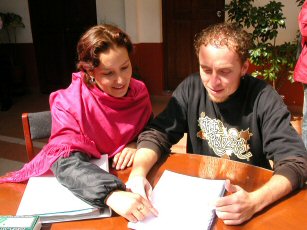
Make your second language learning strategies a many-pronged effort: visit a country where the language is spoken, stay with a family, read material in the local language, and take lessons.
- Looking for a language school or a foreign language class? Define your goals, ask lots of questions, look for flexibility.
- But if, after you enroll, your classes aren't right for you . . . ask for help. Good teachers will adapt to your needs.
- Then, make sure you don't bite off more than you can chew. Also, remember that time flies: schedule accordingly.
Read real language immersion examples,
Click here for Learn Spanish Grammar in Peru
Click here for Typical Day Learning Foreign Language: Peru
Read The Whole World Guide to Language Learning
Daily Learning Cycle
Quick Links
Step 1: Decide
Step 2: Prepare
Step 3: Practice
Step 4: Communicate
Step 5: Evaluate
And our best tip of all: read The Whole World Guide to Language Learning. Own it, use it. Besides being useful, it is an entertaining read, and it rolls all your second language learning strategies into a handy package you can carry with you.
- It's chock full of specific suggestions.
- It's clear, easy to read, and helpful.
Click here to view some pages from The Whole World Guide. These are only samples the book offers many other practical suggestions for language learning.
Continued - Second Language Acquisition -- Step 5: Evaluate
Return from Second Language Learning to the Daily Learning Cycle
Return to Your Language Guide home

Immersion Works
There is no better and more effective way to learn a language than to be immersed in a culture that speaks the language you are learning. You're surrounded by the language on a daily basis and are seeing and hearing it in the proper cultural context. Language learning happens most quickly under these circumstances. --www.vistawide.com
The Whole World Guide
Love the ideas and language learning tips here in our website? Want to learn more about the Walkabout method? Buy your own copy of The Whole World Guide to Language Learning: How to live and learn any foreign language.
This book is chock full of ideas on how to use Walkabout language learning. It has sample lesson plans as well as language learning drills and practice tips. Order your copy today.

Now Available Study Abroad Handbook
Planning to study abroad? Having a hard time choosing a program?
Check out our helpful guide "How to Choose an International Study Abroad Program."
Best of all, it's a FREE download.
Multicultural Literature
Check out the latest additions to our multicultural literature section: Multicultural Stories.This section offers both fictional and non-fictional stories and essays set in regions around the world.
You can read them on line for FREE.
Then why not use the button below, to add us to your favorite bookmarking service?
Copyright© 2007-2016 YourLanguageGuide.com
All rights reserved.
Return to top
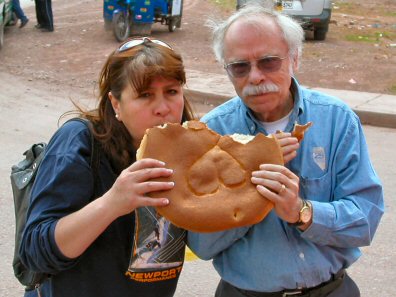 As you work on second language learning, step four is to practice your intercultural communication in
real live situations with native speakers. This language immersion is key when you are doing a language
exhange. This page is chock full of language acquisition tips. After you've read the ideas and suggestions here, check out Owen Lee's
As you work on second language learning, step four is to practice your intercultural communication in
real live situations with native speakers. This language immersion is key when you are doing a language
exhange. This page is chock full of language acquisition tips. After you've read the ideas and suggestions here, check out Owen Lee's
 As we mentioned above, daily tasks some mundane, some vital can drive your language acquisition needs.
Whether you are looking for souvenirs for the family, a small comfort from back home, bottled water, or medical care,
use this second language learning strategy to extract a lesson from the task at the same time you improve your chances
of success. To review:
As we mentioned above, daily tasks some mundane, some vital can drive your language acquisition needs.
Whether you are looking for souvenirs for the family, a small comfort from back home, bottled water, or medical care,
use this second language learning strategy to extract a lesson from the task at the same time you improve your chances
of success. To review:
New! Comments
Have your say about what you just read! Leave me a comment in the box below.